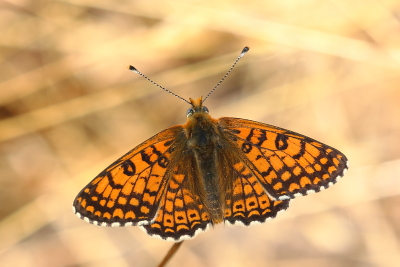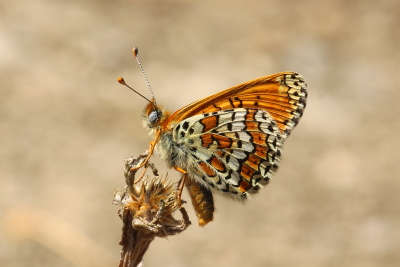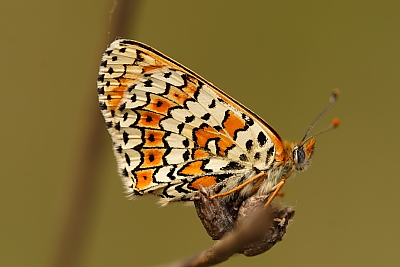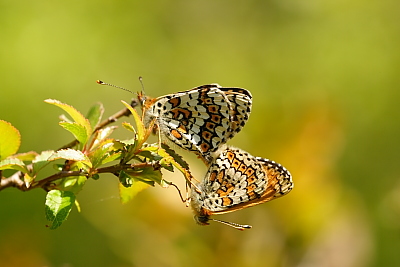











Glanville
Fritillary
2025 photographs highlighted in green. Click on any photograph to go to an enlarged picture, or simply scroll down the page.
|
Quite common in central and southern France, in fact it is widespread and often common, contrasting with its range in the UK which is limited to the Isle of Wight and (allegedly) a mainland coastal location in Somerset, and I believe it flies at Hutchinson's Bank in Surrey where I think it was an introduction.
It is an early season butterfly, emerging in April and having all but disappeared in the far south by the end of May, although this is not true of other parts of France further north. |
The uppersides are very similar to the
ex-Mellicta
genus although it belongs to the original Melitaea group. It
is superficially similar to many other fritillaries, but the black spots in the
uph post-discal spaces make it easily distinguishable from its relatives, at
least in France.
The undersides are very
different to ex-Mellicta species, showing why cinxia was
classified as being of the Melitaea
genus. This was the case until
2010 when the new European taxonomy was issued which groups the Mellicta
species under the Melitaea genus. A superb video of the life-cycle of cinxia has been produced by Filming VarWild and can be viewed on YouTube here: www.youtube.com/watch?v=y4WA_Yt18kk |
| ref | sex |
observations |
alt. m |
| 10446 | M |
a rather dark male, the dark chequered borders contrasting nicely with the fresh white fringes. |
1000 |
| 35226 | M | a dark male from higher altitude, perhaps a little darker than 10446. | 1080 |
| 53666 | M | a male. The time of this photograph was during a very hot and extended heatwave in southern France, 40C every day for over a week. As such, at this location very few butterflies flew. 53666 looked immaculate as if it had just emerged and its pristine condition suggested that was the case. It stayed in this pose for some 20 minutes and then closed its wings, showing its underside in 53670. | 60 |
| 14939 | F |
a female, based on the heavier markings and the roundness of what is just visible of the body. |
220 |
| 17458 | F |
a very dark female from high altitude. It is actually a mating pair, male just visible below. |
2000 |
| 24454 | PAIR | a mating pair, the female on top and with wings open. | 700 |
| 42512 | F | a rather dusky and heavily marked female, perhaps unusual in that it was a lowland specimen. 42517 is the underside. | 140 |
| 24337 | M | the underside of a freshly emerged male. | 220 |
| 53670 | M | a male, the underside of 53666. | 60 |
| 15132 | PAIR |
a mating pair, female above. The female is more heavily marked and this seems to be consistent for most or all of the specimens I have seen. |
450 |
| 5142 | F |
a female, the pose indicating that it was roosting for the night. The black spots are quite heavy in the post-discal orange band, suggesting female. |
220 |
| 42517 | F | a female, the underside of 42512. The discal band is particularly white and the spots in the post-discal band are very large. | 140 |
10446_male_Alpes-Maritimes_9May08
35226_male_Alpes-Maritimes_3Jun14
17458_female_Hautes-Alpes_08Jul09
24454_female_Alpes-de-Haute-Provence_02May11